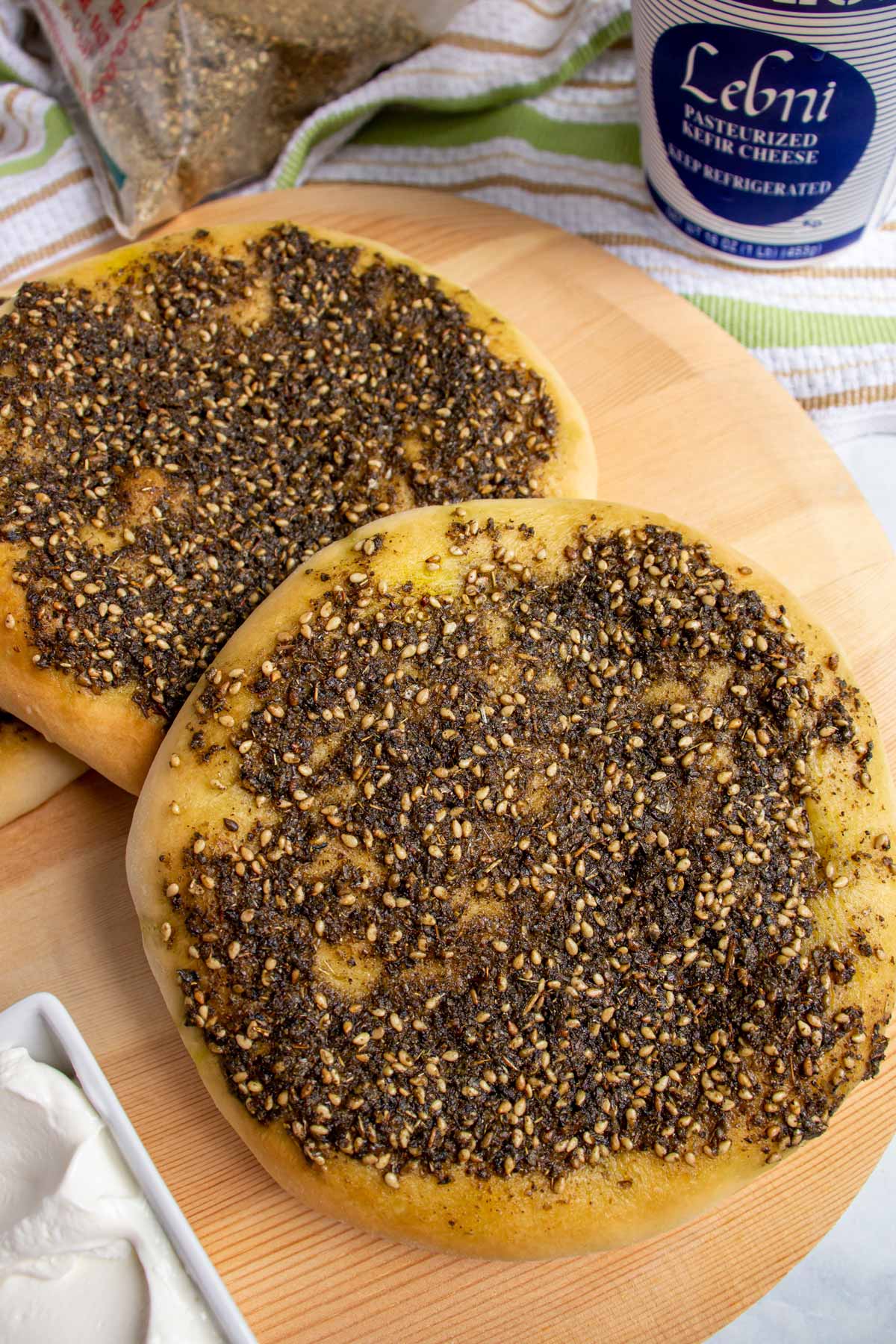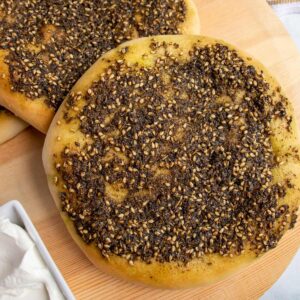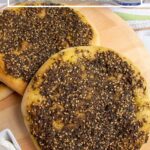Za'atar manakish (Manakeesh) is a popular Levantine flatbread featuring za'atar, a Middle Eastern spice blend. Za'atar bread is easy to make and bakes rather quickly, making it excellent for breakfast or lunch, or as part of a meze platter.

(This recipe was originally published in July 2017, but was updated with new photos and content in 2021).
Manakish (مناقيش, also spelled manakeesh / manaqish, or manouche / man'ousheh in its singular form) is a Mediterranean and Levantine flatbread somewhat similar to pizza. Classic toppings for manakish include akkawi or kashkaval cheese, ground lamb, chili, or the most popular option which is za'atar, a Middle Eastern spice blend.
My maternal grandfather actually grew up in Beirut, Lebanon, so I have a strong affinity for Lebanese food and flavors. Za'atar is one of my favorite spices and I absolutely love using it throughout my cooking. Therefore making homemade za'atar manakish is a given!
This easy za'atar bread bakes quickly and is bit fluffier than a typical flatbread. It's soft and squishy on the inside with a beautifully spiced za'atar crust on top.
Ingredient notes

- Yeast: This za'atar bread recipe uses active dry yeast. I have not tested it with different types of yeast, however I will provide general substitution guidelines in case you need to try them.
- Instant yeast: reduce the amount of yeast by 25% and mix the yeast directly into the flour mixture. Proceed with the recipe as directed.
- Fresh yeast: double the amount of yeast and crumble it into your warm milk mixture. Proceed with the recipe as directed.
- Flour: This recipe uses all-purpose flour. When measuring flour, weight measurements are most accurate using a digital scale. This is what I recommend, and what I use. To measure in cups, spoon the flour into the measuring cup and level it off, don't scoop. Scooping flour packs the flour into the cup, and you will end up with more flour than you expected.
- Za'atar: Za'atar is a Middle Eastern spice blend containing dried herbs (such as dried wild thyme) as well as sumac and sesame seeds. It's popular in Middle Eastern and Levantine cuisine. It has a slight sourness to it (from the sumac) and is excellent sprinkled over labneh (a thick yogurt cheese). It's particularly lovely as a topping for freshly baked bread such as these Lebanese za'atar manakish. If you purchase za'atar in a bag, transfer it to an airtight container to retain optimal freshness.

How to make it
Combine warm water, yeast, and honey in the bowl of a stand mixer and mix together. Set aside until foamy, about 5 minutes.
Add flour, salt, and olive oil to the yeast mixture. Using the dough hook, knead on low speed until a smooth dough is formed, about 5 minutes. The final result should be tacky but not too sticky.
Remove the dough from the bowl and, using your hands, shape into a smooth ball (PHOTO 1). Place dough in a clean, lightly oiled bowl. Cover with plastic wrap and let rise at room temperature until doubled in size, about 1 hour (PHOTO 2).

Preheat the oven to 425°F. Line a baking sheet with parchment paper and set aside.
Divide the dough into six equal portions. Shape each portion into a smooth ball (PHOTO 3), then one by one flatten, spread, and stretch each ball into a circle about ¼ inch thick and 6-inches in diameter. Place each disc of dough on the prepared baking sheet and repeat with the remaining dough until you have 6 flat discs of dough (PHOTO 4).

Stir together olive oil and za'atar to make the topping.

Use a spoon to divide it over the 6 discs of dough, spreading it evenly and leaving just a small border at the edges (like a pizza) (PHOTO 5). Bake the za'atar breads until they just start to brown around the edges, 14 to 16 minutes (PHOTO 6).

Za'atar manakish are best served warm but are also delicious at room temperature.
Please scroll to the bottom of the post for the full recipe (in a printable recipe card) including ingredient amounts and detailed instructions.

Expert tips
Wrap cooled leftover manakish in plastic wrap or store in an airtight container for 2 to 3 days at room temperature or up to 1 week in the fridge. You may also freeze well-wrapped za'atar bread for up to 3 months. Thaw it in the fridge before enjoying.
To reheat/refresh leftover manakish heat it in a 350°F oven or toaster oven until heated through.
Za'atar manakish is typically enjoyed for breakfast or lunch. Include it as part of a Mediterranean breakfast plate alongside boiled or fried eggs, fresh or roasted tomatoes, cucumbers, briny olives, and labneh (thick yogurt cheese). Incorporate it into a meze platter with sliced feta or halloumi cheese, olives, labneh or hummus, and vegetarian stuffed grape leaves. Or eat it simply on its own!
Labneh is unsurprisingly one of my favorite accompaniments to za'atar and I highly recommend you try them together! I purchase mine at Middle Eastern markets but you might also find it in well-stocked supermarkets.

Other recipes you may like
- Spinach Fatayer (Lebanese Spinach Pies)
- Zankou Chicken Garlic Sauce (Copycat Recipe)
- Tomato Bulgur Pilaf
- Chicken Shawarma Wrap
- Kibbeh bil Sanieh (Baked Kibbeh)
- Kibbeh Nayeh / Cig Kofte (Raw Kibbeh)
- Qatayef Asafiri / Atayef bil Ashta (Middle Eastern Cream Filled Pancakes)
- Kadaif or Kadayif (Cheese Kunafa Recipe)
Tried this recipe? Please leave a star ⭐️⭐️⭐️⭐️⭐️ rating in the recipe card below and/or a review in the comments section further down the page. You can also follow me on social media on Facebook, Instagram, and Pinterest!

Za'atar Manakish (Lebanese Za'atar Bread)
Ingredients
Dough:
- 1 cup warm water (about 100 to 115°F)
- 2 ¼ teaspoons (7 grams / 1 envelope) active dry yeast
- 2 tablespoons honey
- 3 ¼ cups (400 grams) all-purpose flour, plus more as needed
- 1 ½ teaspoons kosher salt
- 2 tablespoons extra-virgin olive oil
Topping:
- ¼ cup extra-virgin olive oil
- 6 tablespoons za’atar
Instructions
- Combine the warm water, yeast, and honey in the bowl of a stand mixer and mix together. Set aside until foamy, about 5 minutes.
- Add the flour, salt, and olive oil to the yeast mixture. Using the dough hook, knead on low speed until a smooth dough is formed, about 5 minutes. If the dough is a little stiff, you may need to add an additional 1 to 2 tablespoons water. If it's very sticky, you may need to add an additional 1 to 2 tablespoons flour. The final result should be tacky but not too sticky.
- Remove the dough from the bowl and, using your hands, shape into a smooth ball. Place dough in a clean, lightly oiled bowl. Cover with plastic wrap and let rise at room temperature until doubled in size, about 1 hour.
- Preheat the oven to 425°F. Line a baking sheet with parchment paper and set aside.
- Divide the dough into 6 equal portions (about 115 grams or 4 ounces each). Shape each portion into a smooth ball, then one by one flatten, spread, and stretch each ball into a circle about ¼ inch thick and 6-inches in diameter.
- Place each disc of dough on the prepared baking sheet and repeat with the remaining dough until you have 6 flat discs of dough.
- Stir together the olive oil and za'atar and use a spoon to divide it over the 6 discs of dough, spreading it evenly and leaving just a small border at the edges (like a pizza).
- Bake the breads until they just start to brown around the edges, 14 to 16 minutes. These are best served warm but are also delicious at room temperature.
Notes
- Wrap cooled leftover manakish in plastic wrap or store in an airtight container for 2 to 3 days at room temperature or up to 1 week in the fridge. You may also freeze well-wrapped za'atar bread for up to 3 months. Thaw it in the fridge before enjoying.
- To reheat/refresh leftover manakish heat it in a 350°F oven or toaster oven until heated through.
- Za'atar manakish is typically enjoyed for breakfast or lunch. Include it as part of a Mediterranean breakfast plate alongside boiled or fried eggs, fresh or roasted tomatoes, cucumbers, briny olives, and labneh (thick yogurt cheese). Incorporate it into a meze platter with sliced feta or halloumi cheese, olives, labneh or hummus, and vegetarian stuffed grape leaves.
Nutrition
*All nutritional information is based on third-party calculations and should be considered estimates. Actual nutritional content will vary with brands used, measuring methods, portion sizes and more.*







Jan
Great recipe! I let the dough sit 15-30 minutes after I divided it into balls. They stretched out nicely. The dough holds up well under the ingredients. I topped half with za'atar and the other half with a mix of akawi and feta cheeses with nigella seeds. (I made a double batch.) Delicious!
Suzanka
Do you think i can use the pasta roller and then circle cookie cutters? Or would that knead the dough too much?
Victoria
Hi Suzanka,
I don't think using a pasta roller would be a good idea here. Not only would it roll the dough out too thin, but you would likely need to dust it with a lot of flour to make sure it doesn't stick in the roller, and would add more flour than needed to the dough. Also, most circle cookie cutters don't come in sizes large enough to cut out 6-inch circles of dough.
Kelly
Delicious! We used my tortilla press to flatten them, then cooked them in the Breville Pizza Maker, we couldn’t keep up with the speed at which they were being eaten!